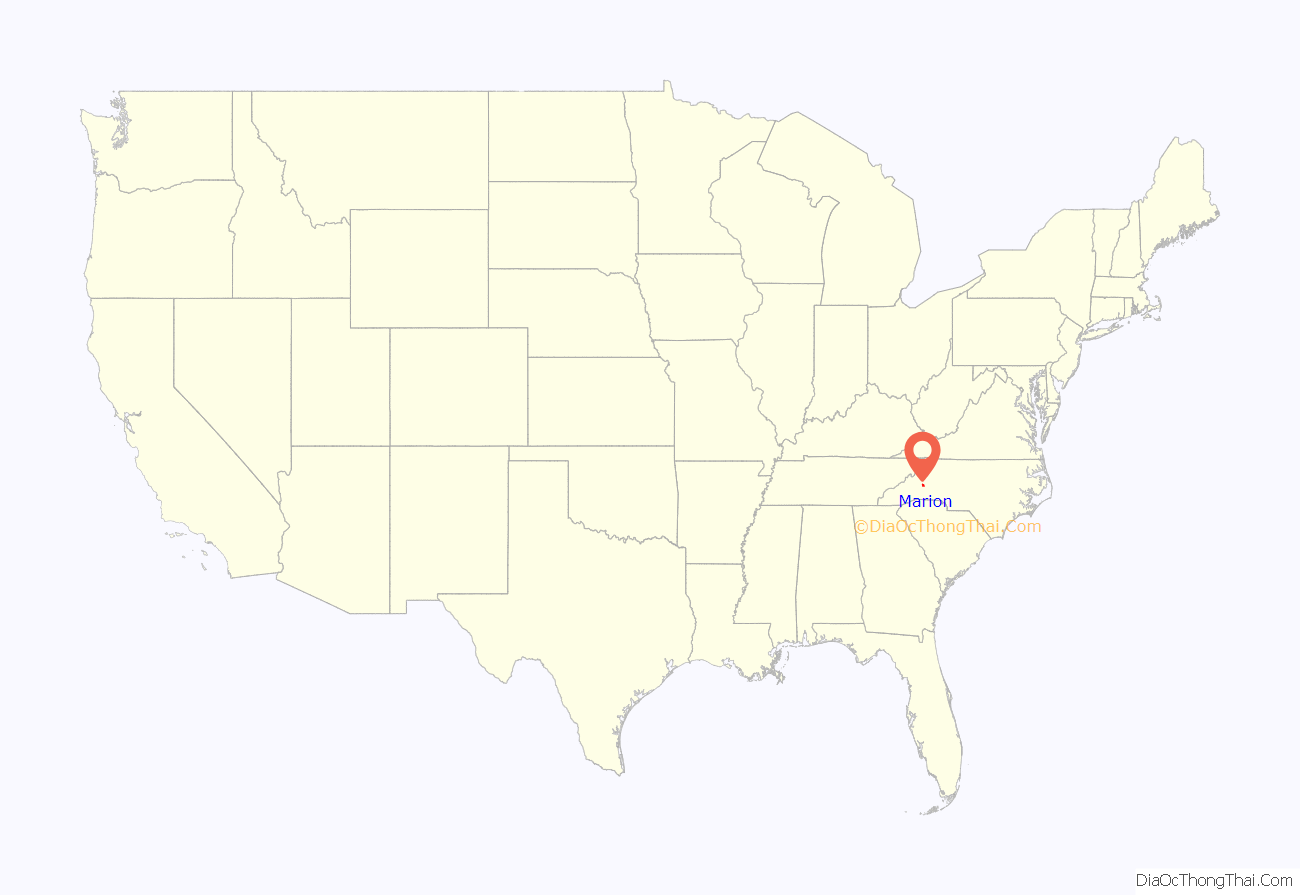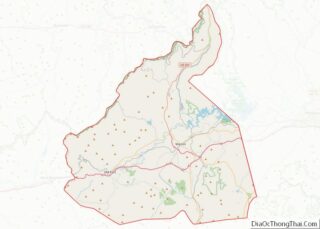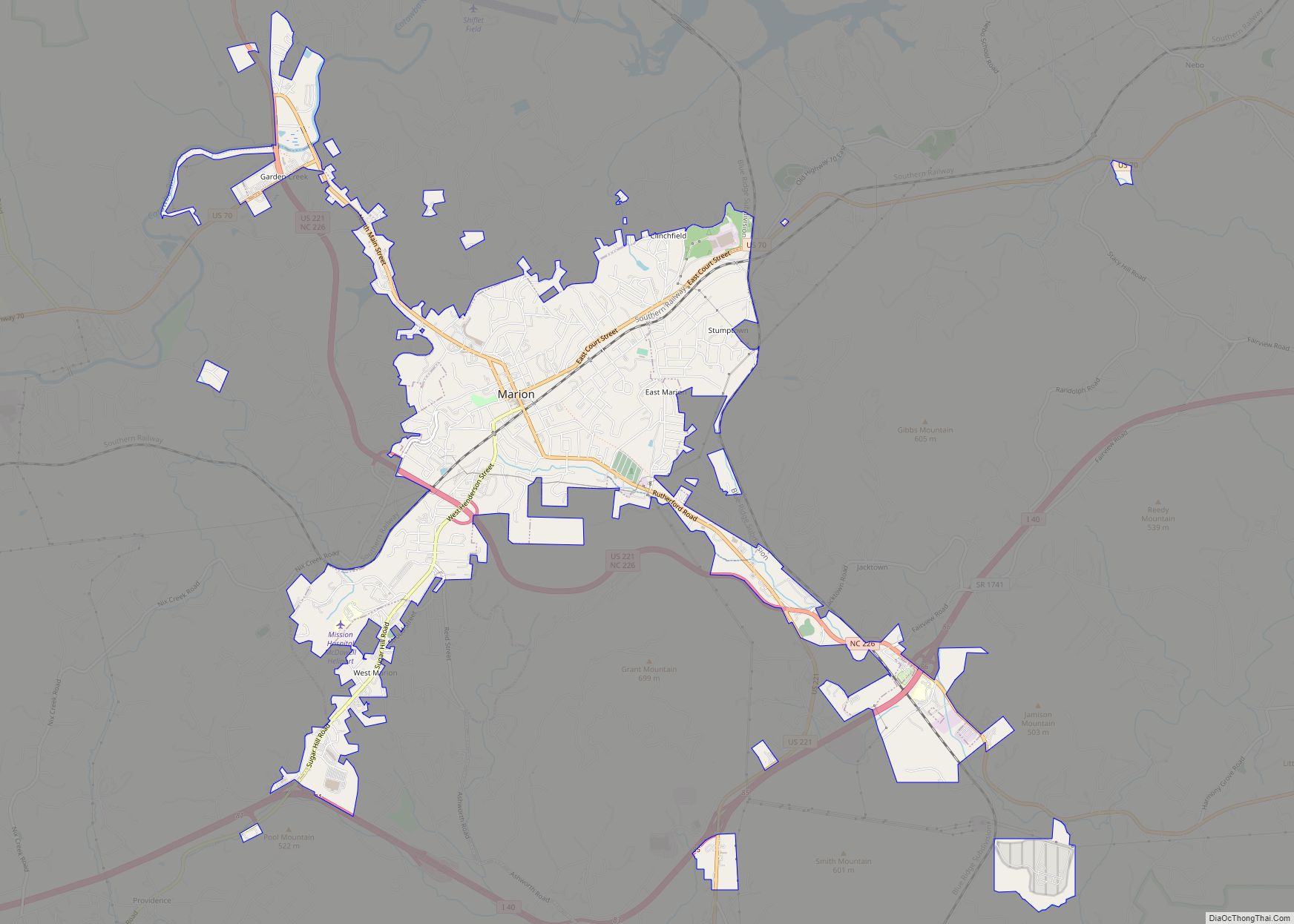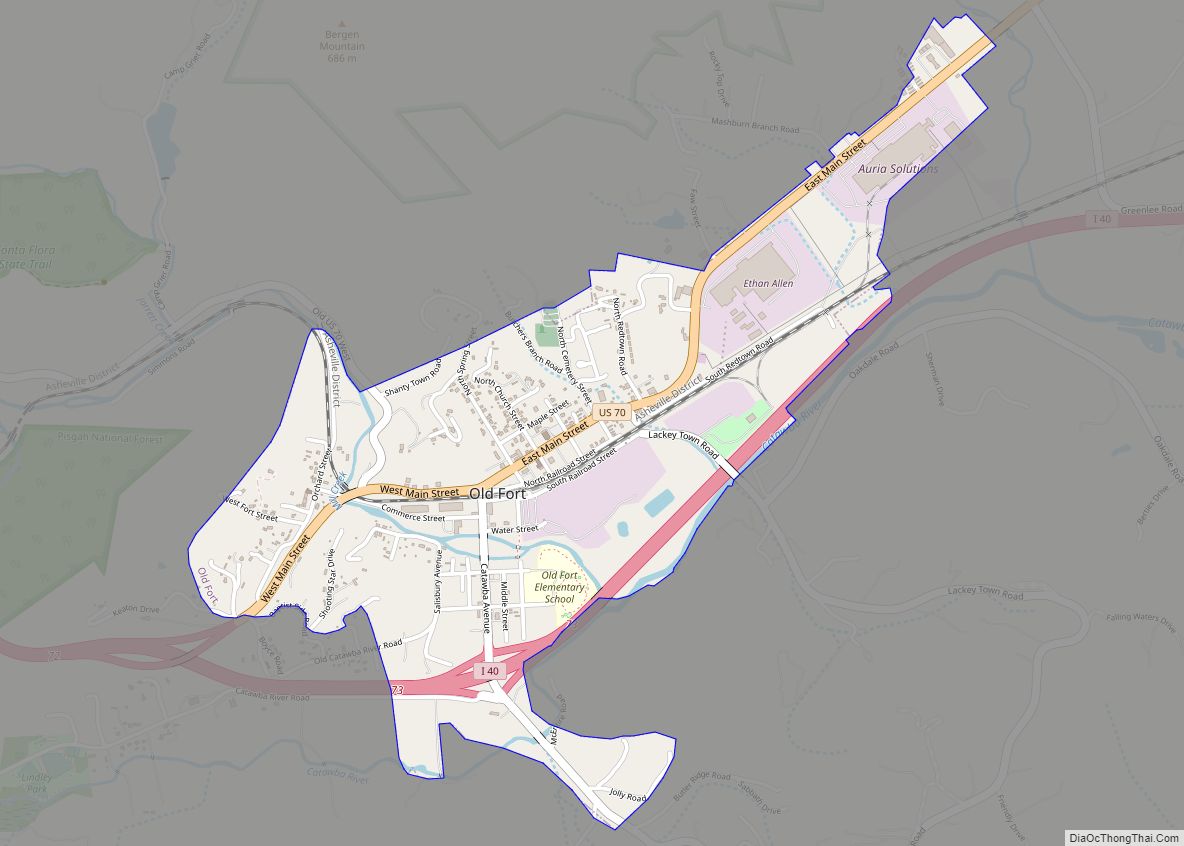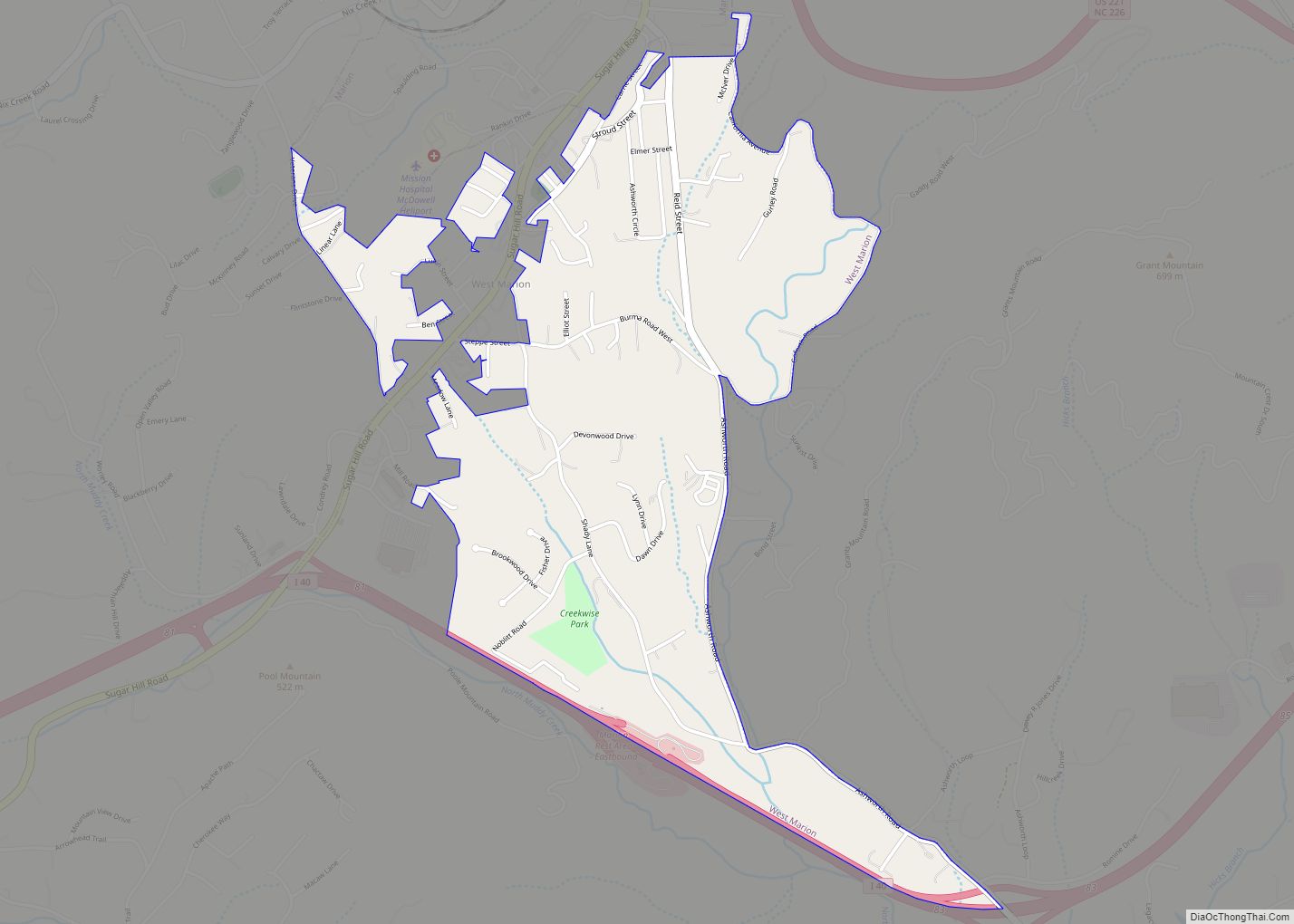Marion is a city in and the county seat of McDowell County, North Carolina, United States. Founded in 1844, the city was named in honor of Brigadier General Francis Marion, the American Revolutionary War Hero whose talent in guerrilla warfare earned him the name “Swamp Fox”. Marion’s Main Street Historic District is listed on the National Register of Historic Places. The population was 7,717 at the 2020 Census.
| Name: | Marion city |
|---|---|
| LSAD Code: | 25 |
| LSAD Description: | city (suffix) |
| State: | North Carolina |
| County: | McDowell County |
| Founded: | 1844 |
| Elevation: | 1,404 ft (428 m) |
| Total Area: | 6.00 sq mi (15.55 km²) |
| Land Area: | 5.97 sq mi (15.47 km²) |
| Water Area: | 0.03 sq mi (0.08 km²) |
| Total Population: | 7,717 |
| Population Density: | 1,291.98/sq mi (498.80/km²) |
| ZIP code: | 28752 |
| Area code: | 828 |
| FIPS code: | 3741420 |
| GNISfeature ID: | 1013324 |
| Website: | www.marionnc.org |
Online Interactive Map
Click on ![]() to view map in "full screen" mode.
to view map in "full screen" mode.
Marion location map. Where is Marion city?
History
Marion, the county seat of McDowell County, was planned and built on land selected by the first McDowell County Commissioners on March 14, 1844 at the Historic Carson House on Buck Creek. It was not until 1845, however, that the official name of Marion was sanctioned as the county seat by the state legislature. The name of Marion came from Brigadier General Francis Marion, the American Revolutionary War hero, known as the “Swamp Fox” and the man upon whom the movie The Patriot was based. Marion was also home to Sgt. Daniel Kanipe, one of only two survivors of the Battle of Little Bighorn. An historical marker was placed in front of his former home in 2011. The nearby Lake James is a local tourist attraction, and has been the backdrop for movies such as The Last of the Mohicans and The Hunt for Red October.
Another famous house in Marion is the Joseph McDowell House, built in 1787 by the county’s namesake, Joseph McDowell. McDowell played a large role in the Battle of Cowpens when he helped defeat the British in January 1781. McDowell went on to serve as a member of the North Carolina Constitutional Convention in 1788 and was a member of the 3rd United States Congress. Restoration plans are underway to preserve this historic house and ensure that it remains a vital part of Marion’s history. In 2010, the Joseph McDowell Greenway opened to the public along the Catawba River, and will soon link the two most historic homes in McDowell County, the Joseph McDowell House and the Carson House.
The Big Fire
Until the late 19th century, Main Street was a collection of mostly wooden huts, houses, and buildings. On Sunday morning, November 25, 1894 a fire sprang up in an old building known as the “Ark” located behind the Courthouse. The fire spread to Main Street and rushed down the street at an incredible pace. The wooden buildings were quickly consumed by the enormous inferno. The few brick buildings on Main Street were also gutted, and because there was no public water supply, bucket brigades were hurriedly formed to halt the advance of the fire. It was not enough, however, and most of Main Street was burned to the ground. Showing the resiliency possessed by the citizens, the city came together and took on the rebuilding process, making Marion larger and stronger than before. Today, downtown Marion is listed in the National Register of Historic Places.
Depression Era & Labor Conflict
On Oct. 2, 1929, the McDowell County sheriff and several deputies faced a group of workers outside the fence in front of the Marion Manufacturing Company, whose 600 employees had been on strike for four months. A gunfight quickly ensued between the two groups. Sheriff Oscar Adkins would later swear in court that the strikers opened fire first, although no weapons were ever found on any of the strikers. 36 strikers were shot, six mortally, during the confrontation. Sinclair Lewis wrote a syndicated newspaper report entitled “Cheap and Contented Labor: The Picture of the Southern Mill Town.” He concluded: “The workers, especially in Marion, have become discouraged. They are hungry, tired, bewildered. They are sick of being shot down. Unless the whole country encourages them [financially], they will crawl back into the slavery I have sought to picture here.” However, since the Great Depression was in the immediate future, little such help would arrive.
Historic District
Eleven structures make up the Main Street Historic District in the downtown area, which was listed on the National Register of Historic Places in 1991. Four churches, St. John’s Episcopal Church (1882), First Baptist (1914), First Presbyterian (1923), and St. Matthew’s Lutheran Church (1935); two former hotels, the Eagle Hotel, which survived the 1894 fire, and the Hotel Marianna (1910); a bank on Main Street built in 1903; the McDowell County Courthouse, which was constructed in 1928; the Marion Depot (1867), which is the oldest surviving depot on the Western Rail Line; the Public Library (1937), which was originally built as a post office; and the Marion Community Building, built in 1937. Also listed on the National Register of Historic Places are the Depot Historic District, Carson House, Carson–Young House, and Lone Beech. Downtown Marion has benefited from recent revitalization, and many new shops, restaurants, and taprooms have opened up along Main Street in recent years.
Marion Today
Marion currently stands as a small congenial town at the edge of the Blue Ridge Mountains, “Where Main Street Meets the Mountains.” Just off Interstate 40, Marion is located approximately 35 miles east of Asheville and 20 miles west of Morganton.
Marion was named “North Carolina Small Town of the Year” for 2018 from the N.C. Rural Center. The Small Town of the Year Award recognizes a town or small city “that embraces citizen engagement, values diversity, and fosters strong partnerships.”
Marion serves as a gateway from Interstate 40 to many nearby attractions and recreation activities in the Blue Ridge Mountains. A contemporary rest area located on the US 221 bypass west of Marion serves as a welcome center for visitors to the area. The rest area and visitor center is staffed with travel counselors during daylight hours. In addition to providing visitor information, it also has picnic facilities and vending machines on the premises.
The Marion Marauders, a Tar Heel League baseball club, were a favorite local attraction in the 1940s and 1950s, and were the home team of star pitcher Kelly Jack Swift, who in 1953 became the last minor league pitcher to ever win 30 games in a season, going 30–7 with a 2.54 ERA. Sports Illustrated published an article about Swift and his accomplishment in its October 17, 2011 edition.
Former University of North Carolina Tar Heels basketball coach and 2007 Basketball Hall of Fame inductee Roy Williams was born and spent a part of his childhood in Marion. On July 18, 2011, the town held a ceremony to dedicate a Carolina blue historical marker downtown in front of City Hall, listing Marion as the birthplace of Coach Williams, as well as his many awards and accomplishments.
Marion continues to be a community that values athletics, especially the “Fightin’ Titans” of McDowell High, whose girls’ basketball team won the 1992 North Carolina 4A State Championship.
Marion Road Map
Marion city Satellite Map
Geography
Marion is located at 35°40′59″N 82°0′21″W / 35.68306°N 82.00583°W / 35.68306; -82.00583 (35.683150, -82.005855).
According to the United States Census Bureau, the city has a total area of 5.6 square miles (15 km).
See also
Map of North Carolina State and its subdivision:- Alamance
- Alexander
- Alleghany
- Anson
- Ashe
- Avery
- Beaufort
- Bertie
- Bladen
- Brunswick
- Buncombe
- Burke
- Cabarrus
- Caldwell
- Camden
- Carteret
- Caswell
- Catawba
- Chatham
- Cherokee
- Chowan
- Clay
- Cleveland
- Columbus
- Craven
- Cumberland
- Currituck
- Dare
- Davidson
- Davie
- Duplin
- Durham
- Edgecombe
- Forsyth
- Franklin
- Gaston
- Gates
- Graham
- Granville
- Greene
- Guilford
- Halifax
- Harnett
- Haywood
- Henderson
- Hertford
- Hoke
- Hyde
- Iredell
- Jackson
- Johnston
- Jones
- Lee
- Lenoir
- Lincoln
- Macon
- Madison
- Martin
- McDowell
- Mecklenburg
- Mitchell
- Montgomery
- Moore
- Nash
- New Hanover
- Northampton
- Onslow
- Orange
- Pamlico
- Pasquotank
- Pender
- Perquimans
- Person
- Pitt
- Polk
- Randolph
- Richmond
- Robeson
- Rockingham
- Rowan
- Rutherford
- Sampson
- Scotland
- Stanly
- Stokes
- Surry
- Swain
- Transylvania
- Tyrrell
- Union
- Vance
- Wake
- Warren
- Washington
- Watauga
- Wayne
- Wilkes
- Wilson
- Yadkin
- Yancey
- Alabama
- Alaska
- Arizona
- Arkansas
- California
- Colorado
- Connecticut
- Delaware
- District of Columbia
- Florida
- Georgia
- Hawaii
- Idaho
- Illinois
- Indiana
- Iowa
- Kansas
- Kentucky
- Louisiana
- Maine
- Maryland
- Massachusetts
- Michigan
- Minnesota
- Mississippi
- Missouri
- Montana
- Nebraska
- Nevada
- New Hampshire
- New Jersey
- New Mexico
- New York
- North Carolina
- North Dakota
- Ohio
- Oklahoma
- Oregon
- Pennsylvania
- Rhode Island
- South Carolina
- South Dakota
- Tennessee
- Texas
- Utah
- Vermont
- Virginia
- Washington
- West Virginia
- Wisconsin
- Wyoming
